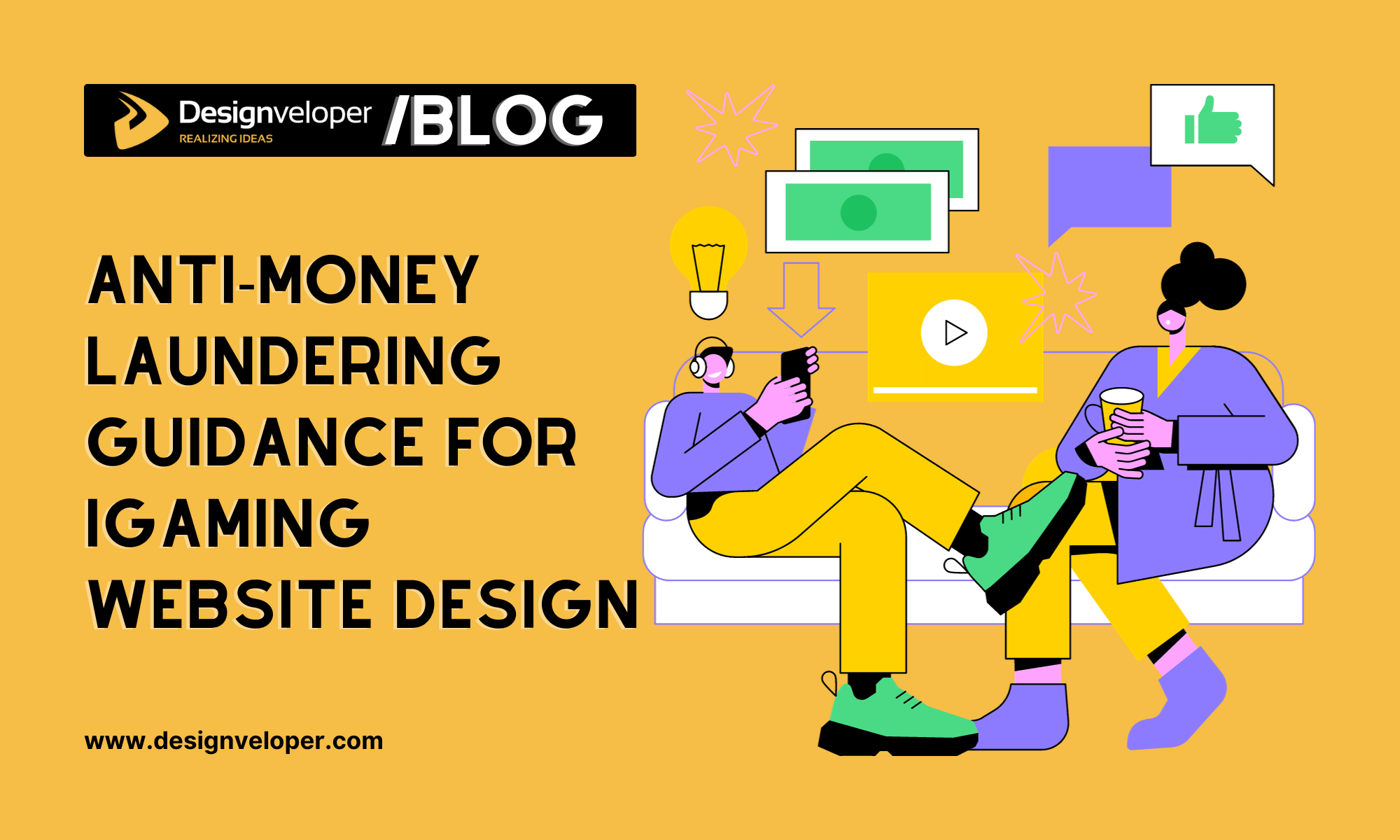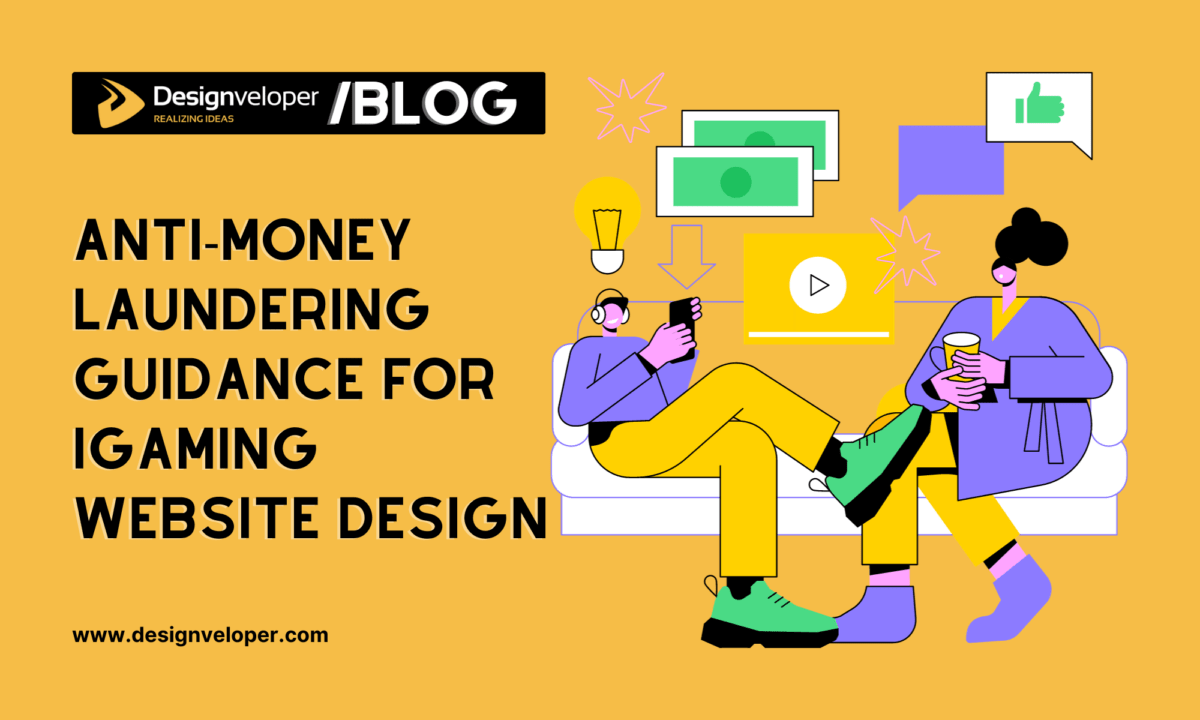If you’re a designer looking into a new market or niche in 2024, you might want to consider learning how to design for iGaming website. If you’re wondering why you should consider that industry in the same place, it’s because iGaming is a booming business. Their revenue is expected to show an annual growth rate of 9.02%, which means they could hit $124.20bn by 2027. With an expected 233.7m users in that same year, demand for designers is likely to go up.
In this article, we’ll take you through all the basics you need to know to become a knowledgeable designer for iGaming businesses, and how you can help keep them and their users safe.

Understanding AML in the iGaming landscape as a designer
To understand how important money laundering prevention is in the iGaming industry, it’s crucial to know why the business is so hip and happening – because everything is connected.
- Internet penetration: around 64.4% of the global population is now online. This means there’s a significant potential user base for online gaming.
- Legalization continues: the Netherlands legalized it in 2021, and countries like Canada and India recently joined the club as well. This paves the way for operators to capture new markets.
- Payments are easier to make than ever and mobile wallets are growing in popularity. Add to that the increased security on online payments, and you’ll win the users’ trust (and money.)
But more payment methods and more security features don’t mean it’s an airtight system. And iGaming is, in fact, a ‘great’ place for money laundering.
Recommended reading: Creating Cross-Platform Games with Unity and Backend Web Server Using Laravel
1. How money laundering in iGaming works
To design armor against your enemy, it’s essential to understand how they work. And that’s where a quick explanation of money laundering comes in handy.
Money laundering is an old practice, in which illegally obtained funds are being ‘washed clean’ by putting them into the legitimate economy. Here’s a simplified process:
- Placement: illegal money is deposited into an iGaming account.
- Layering: the money is used for small bets or games to disguise its source.
- Integration: after some activity, the money is withdrawn, appearing as legitimate gambling winnings.
After this process, it is incredibly hard if not impossible to check where money has come from – and that’s what criminals love.
2. Main tactics of money laundering in iGaming and online gambling
So, how does this work in the world of iGaming? There are various tactics that are being used, but these are the three most common ones:
- Account cycling: a user opens a betting account, completes verification with an ID and bank account, and then deposits funds using various payment methods. They place a few small bets to mimic normal activity, and eventually cash out, effectively laundering the money through a legitimate casino.
- Collaborative losses: in this scheme, a money launderer colludes with accomplices at a virtual betting table, like poker. The accomplices intentionally lose, channeling the majority of funds to the launderer, thereby detaching the money from its illicit origins. They accept some losses as the cost of laundering.
- Transaction through gameplay: this method involves a buyer and seller of illegal goods partaking in the same game. The buyer transfers funds to the seller under the guise of betting. The seller then withdraws these funds as supposed gambling winnings, masking their link to criminal activities.
3. AML compliance regulations vary across regions
The bad news is that every country has its own rules and regulations regarding what effective measures need to be taken against money laundering. The good news is that there is a lot of overlap, such as:
- Mandatory identity verification: most countries require thorough customer identity checks (Know-Your-Customer processes)
- Reporting suspicious activity: regulations commonly mandate swift reporting of unusual or suspect transactions
- Transaction monitoring: an obvious one, but this is necessary to identify patterns that hint at money laundering
- Risk assessments: you can’t just sit back and wait to see if anything happens. Most countries require proactive risk assessments
- Record-keeping: detailed records of customer transactions and ID verifications need to be kept for specified periods
While that is not always directly related to design choices, it is good to be up to speed with this and to be engaged with legal or anyone overseeing compliance, so you don’t have to go back and forth in your designs. Now, let’s get to the designing part.
Why AML is important for designers in the iGaming industry
The short answer? Because it matters to your iGaming clients.
The long answer is this: you might think that after you’re done designing, any cases of money laundering are not for you to worry about. And while of course the blame is never on the designer, you can, in fact, play an active role in preventing it. With your skills and making even the smallest possible design nuances, you could prevent people from becoming the victims of money laundering – and can help protect iGaming companies as a whole.

Designing for iGaming with AML in mind
You already know that design isn’t only about looks, even in the realm of iGaming, where aesthetics play a big role in the user experience. What goes on behind the front end is all about creating a smart, secure, and intuitive environment. And AML is a part of that, so it’s crucial to create a balance between design and functionality.
By integrating features like identity checks and transaction monitoring into your design that is smooth and user-friendly, you help people safely use an iGaming website. With seon’s AML monitoring, you can do it in a user- and designer-friendly way. The secret is to use a solution with an easy integration that helps keep your business safe. Let’s look at some other things to keep in mind when designing for iGaming in terms of AML.
1. Naturally integrating AML into the user experience
You don’t want your AML measures to be super in-the-face of your iGamers. The best way to do it is by integrating the necessary requirements into a seamless UX. That means that checks like identity verification, transaction monitoring, and risk assessment tools find their place in the design in a way that feels natural and unintrusive. Try to make these processes part of the user journey, not an interruption of it.
2. Simplify compliance processes
Another reason to pay extra attention to this is that complex compliance processes can send users running in the wrong way, or even create a brewing ground for mistakes. So, ‘’dumb it down’’ as much as you can.
When looking at it this way, that means you should try out streamlined forms for identity verification, or even add in visual cues that guide users through the AML requirements without feeling overwhelmed. Use color coding, icons, or progress bars to indicate steps completed and what’s next in the AML process.
3. Enhance transparency and trust
Your design choice can build or break trust. You can use elements in your design to educate users about what is happening in terms of AML measures. A quick tooltip, popup, or other brief indicators or explainers make AML regulations more visible, as well as implementing design elements that signal security to the user, like secure lock icons or privacy reminders.
4. Creating a responsive design for AML features to shine in
Work together with the developers on this. Because incorporating AML features only works if they really work. This means designing responsive forms, alters, and check systems that seamlessly adapt to different screen sizes and platforms.
5. Make sure you design for accessibility
AML measures should keep everyone safe, so accessibility is key. Ensure your compliance processes are clear and straightforward, so nobody is left behind.
6. Regular testing and user feedback
Just like in any other design process, designing for AML means that user feedback and testing are a must. Continuously test your designs with real users to ensure that the AML components are intuitive and effective. Gather feedback and be prepared to iterate on your designs to improve the user experience while maintaining rigorous compliance standards.
Terms you should know as a designer in the iGaming industry
- AML: Anti-money-laundering, meant to prevent and detect money laundering.
- KYC: Know-your-Customer, related to verifying client identities to prevent fraud.
- CTF: Counter-Terrorist Financing, related to measures taken to prevent the financing of terrorist activities.
- SAR: Suspicious Activity Report, filed by financial institutions to authorities when a transaction or activity seems suspicious.
- EDD: Enhanced Due Diligence, related to collecting additional information on higher-risk customers.
- SoF: Source of Funds, which is the origin of the money used by customers to play games online.
Eager to dive into iGaming as a designer?
With the incredible growth in the industry, there’s a good chance they will be on the lookout for savvy designers. Start getting your compliance knowledge in, and read more about designing for gaming now to make 2024 your year!
To our readers, whether you’re a startup taking your first steps into the digital arena or a seasoned business aiming to redefine your online identity, consider Designveloper as your partner in this journey. Let’s elevate your digital presence together, transcending the ordinary and creating a virtual space that captivates and converts. In the world of web development, excellence isn’t just a goal; it’s a standard we uphold with every line of code we write and every design element we craft. Your digital evolution starts here.






















